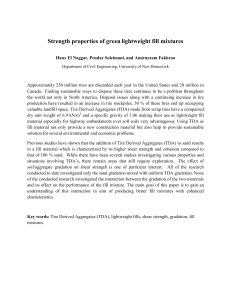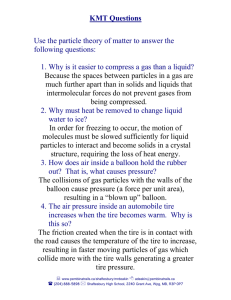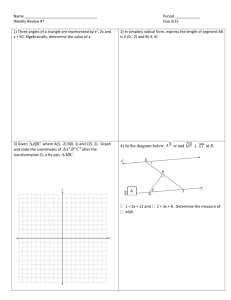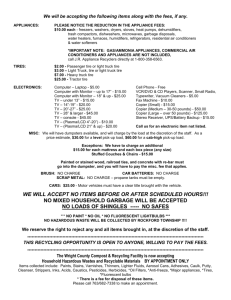R&D related to uses of granulated scrap tire rubber
advertisement
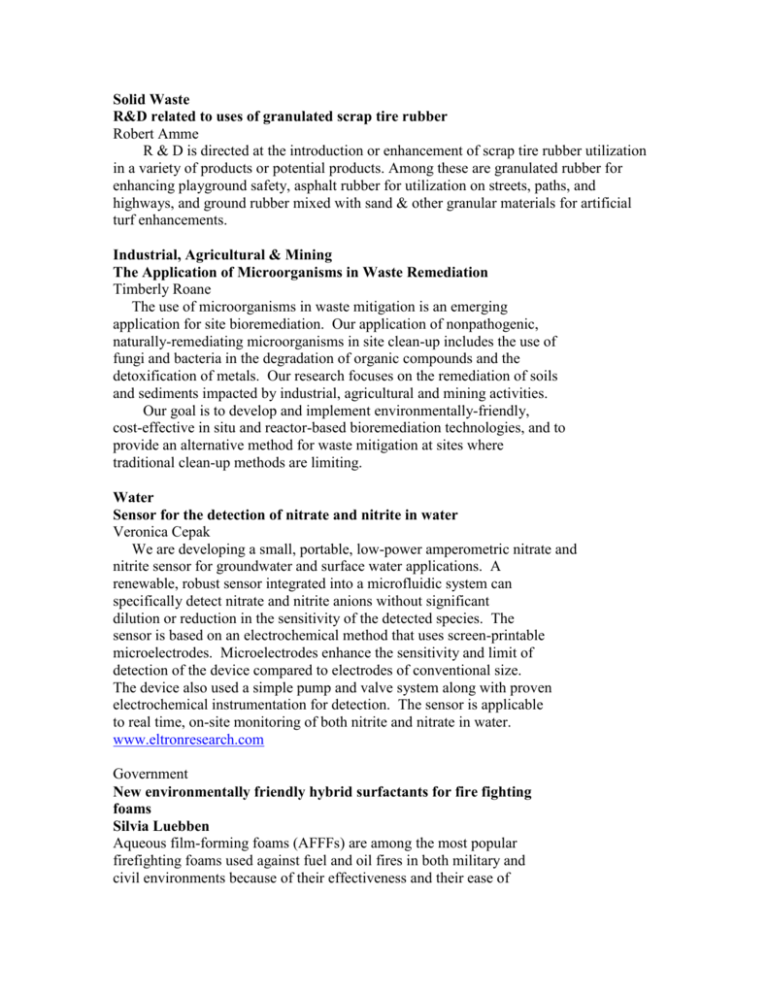
Solid Waste R&D related to uses of granulated scrap tire rubber Robert Amme R & D is directed at the introduction or enhancement of scrap tire rubber utilization in a variety of products or potential products. Among these are granulated rubber for enhancing playground safety, asphalt rubber for utilization on streets, paths, and highways, and ground rubber mixed with sand & other granular materials for artificial turf enhancements. Industrial, Agricultural & Mining The Application of Microorganisms in Waste Remediation Timberly Roane The use of microorganisms in waste mitigation is an emerging application for site bioremediation. Our application of nonpathogenic, naturally-remediating microorganisms in site clean-up includes the use of fungi and bacteria in the degradation of organic compounds and the detoxification of metals. Our research focuses on the remediation of soils and sediments impacted by industrial, agricultural and mining activities. Our goal is to develop and implement environmentally-friendly, cost-effective in situ and reactor-based bioremediation technologies, and to provide an alternative method for waste mitigation at sites where traditional clean-up methods are limiting. Water Sensor for the detection of nitrate and nitrite in water Veronica Cepak We are developing a small, portable, low-power amperometric nitrate and nitrite sensor for groundwater and surface water applications. A renewable, robust sensor integrated into a microfluidic system can specifically detect nitrate and nitrite anions without significant dilution or reduction in the sensitivity of the detected species. The sensor is based on an electrochemical method that uses screen-printable microelectrodes. Microelectrodes enhance the sensitivity and limit of detection of the device compared to electrodes of conventional size. The device also used a simple pump and valve system along with proven electrochemical instrumentation for detection. The sensor is applicable to real time, on-site monitoring of both nitrite and nitrate in water. www.eltronresearch.com Government New environmentally friendly hybrid surfactants for fire fighting foams Silvia Luebben Aqueous film-forming foams (AFFFs) are among the most popular firefighting foams used against fuel and oil fires in both military and civil environments because of their effectiveness and their ease of application. Unfortunately, recent studies have shown that one key ingredient of AFFFs, the fluorosurfactant perfluorooctyl sulfonate (PFOS), is toxic to aquatic life and is a persistent chemical that accumulates in the blood of animals and humans. Thus, the production of PFOSs was stopped in May 2000. Among the phase out products are 44 AFFFs and firefighting foam components. The fire-fighting industry is stocked with materials that have been phased out and that, sooner or later, need to be replaced. Many of the foam concentrates sold today still contain fluorinated surfactants, but they are chemically different from those that have been phased out. Their toxicity and persistency in the environment are unknown and still are under investigation, and their presence in the future market is unsure. Therefore, the fire fighting industry has an urgent need for new environmentally friendly foaming agents and foam stabilizers that will replace the phased-out fluorosurfactants. The objective of this Phase I EPA-sponsored SBIR project was to investigate the surface-active properties of TDA's proprietary additives in water, and evaluate their use as components of fire fighting foam concentrates. TDA's additives form very stable aqueous foams upon mixing with water and air. During the project TDA Research, Inc. developed novel fluorine-free foam stabilizers for fire-fighting foam concentrates. TDA demonstrated that these foam stabilizers are compatible with current fire-fighting equipment and can be used to suppress fuel fires (class B fires). TDA also identified new surfactant types that, in combination with TDA's foam stabilizers, offer the potential to develop an environmentally friendly AFFF replacement product. TDA's additives will find immediate application in foam concentrates for fire fighting. Once their properties are established, TDA's additives could be used in many industries including waste management, construction, paper, textile, detergent, coating and personal care. Water Biological System to reduce odor in anaerobic lagoons Brad Walker Ag Algae is a biological system to reduce odors in anaerobic lagoons. A singlecelled green algae culture is used to produce oxygen in these system. Treatment by aeration has provenm to be an effective method of reducing lagoon odors by encouraging oxidative metabolism. The mechanical aeration of lagoons has a high enrgy requirement. In addition, aerators can be expensive and require maintenance. By using photosynthetic oxygenation of Ag Algae, odor reduction is achieved without the high energy requirement. Ag Algae systems are currently employed at two swine lagoons at separte facilities located in Southeast Colorado. AgSkill, Inc. is currently trying to market their system to Concentrated Animal Feeding Operations (CAFO) in Colorado and surrounding states. Hazardous Wastes Mandar Sunthankar – IonEdge Chrome Dry Plating to eliminate hazards and waste The “zero-waste” dry plating technology is patented under the EPA SBIR program. The technology involves plating chromium efficiently and econimcally without using liquid chemicals. Solid Waste Jorge Zornberg CU Boulder Beneficial reuse of waste tires in civil engineering infrastructure Tire shreds and tire shred-soil mixtures can be used as alternative backfill material in many geotechnical application. The reuse of tire shreds may not only address growing environmental and economic concerns, but it may also help solving geotechnical problems associated with low soil shear strength. In this study, an experimental testing program is undertaken using a large-scale triaxial apparatus with the; goal of evaluating the optimum dosage and aspect ratio of tire shreds witin granular fills. For a given tire shred content, increasing tire shred aspect ratio lead to increasing overall shear strength, at least for the range of tire shred aspect ratios considered in this study. The shear strength improvement induced by tire shred inclusions was found tto be sensitive to the applied confining pressure, with large shear strength gains obtained under comparatively low confinement. http://civil.colorado.edu/~zornberg Waste Containment Evapotranspirative cover for waste containment in arid climate locations Jorge Zornberg The overall abjective of this initiative is to investigate the mechanisms governing the performance of alternative, evapotranspirative cover systems for waste containment applications. It is expected that this integrated research and education initiative will provide significantr contribution through advancement s in: 1) basic understanding of complex unsaturated flow processes, (2) combines centrifuge and numerical modeling, (3) design of waste cover systems in arid and semi-arid environments, (4) integration of research into engineering education. http://civil.colorado.edu/~zornberg Hazardous Wastes Capture of Chemical Byproducts Al Weimer This is a process for the capture if chemical byproducts of fossil fuel and petrochemical combustion by the molten salt catalyst. Upon “capture,” detoxification of these toxic agents is catalyzed by the motel salts. These chemicals include sulfur species (some of which are responsible for acid rain), toxic nitrogen derivatives, partially consumed hydrocarbons, and chlorine derivatives. The technology can be used to purify emissions from power plants, hazardous waste facilities, and chemical manufacturing facilities. Waste Containment Granular Waste Compaction & recycling Robert Amme R&D is directed at the application of vibrational compaction of granular materials having little value (ashes, soils, recycled concrete wastes, etc) with the aim of producing building materials having high durability and exhibiting physical properties comparable to or better than conventional concrete. We are also investigating means by which compaction and stabilization can be attained for granular materials that have been contaminated by heavy metals &/or radioactive species, thus permitting long-term storage or disposal. Water Recovery of mercury and heavy metals from dental wastewater Craig Turchi ADA Technologies Water Electrocoagulation treatment of bilgewater and shipboard wastewater Craig Turchi ADA Technologies Soil Demonstration of a Small Modular BioPower System Using Poultry Litter John Reardon Community Power Corporation The purpose of this project was to assess poultry grower residue, or litter (manure plus absorbent biomass), as a fuel source for Community Power Corporation's small modular biopower system (SMB). A second objective was to assess the poultry industry to identify potential ''on-site'' applications of the SMB system using poultry litter residue as a fuel source, and to adapt CPC's existing SMB to generate electricity and heat from the poultry litter biomass fuel. Bench-scale testing and pilot testing were used to gain design information for the SMB retrofit. System design approach for the Phase II application of the SMB was the goal of Phase I testing. Cost estimates for an onsite poultry litter SMB were prepared. Finally, a market estimate was prepared for implementation of the on-farm SMB using poultry litter. http://www.osti.gov/bridge/product.biblio.jsp?osti_id=794292 Industrial Coupling Granular Activated Carbon with Common Metal Chelating Corrosion Inhibitors for Two Phase Transition Metal Immobilization Dr. Mark Hernandez University of Colorado at Boulder
